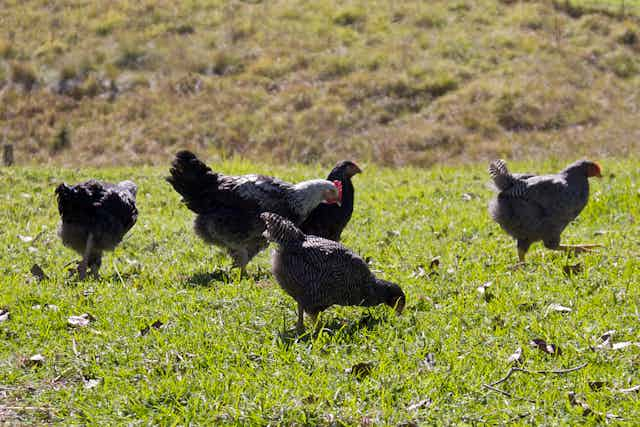While Hong Kong has just reported its first case of the deadly H7N9 bird flu indicating that the virus may be spreading across China, Australia is reporting an egg shortage over Christmas as a result of the recent H7N2 cases in NSW. So how does the virus keep reinventing itself to cause issues across the world?
As over 70 per cent of emerging infectious diseases in people originate in animals, whenever we hear of a new virus outbreak we jump to find the source.
That’s not to vilify the animal species responsible, but to enable scientists to characterise the virus, track its path, assess its level of virulence and its potential impact on animal and human populations. While some recent viruses such as SARS and MERS have been tracked to bats, in the case of avian influenza in people, the source is birds.
Finding the source of influenza
As well as “bird flu” in the past there have also been reports of “swine flu”. In fact both these flu viruses belong to a group known as influenza A, and all influenza A viruses originally come from wild water fowl.
These complex viruses have evolved over time to become infectious to domestic birds such as farmed and back-yard poultry, pigs, horses, other domestic and wild animals and of course people. Cross-species transmissions can occur from time to time.
Viruses that infect more than one species frequently have natural hosts in which they replicate but do not cause obvious disease. The pathogen and host exist in harmony with each other and examples include Hendra, Nipah and SARS viruses in bats, Hanta viruses in rodents and influenza viruses in wild water birds.
On the whole, naturally occurring avian influenza (AI) viruses do not cause disease in wild bird populations. However, if wild water fowl are shedding virus and come in contact with domestic poultry, their food or water, either directly or via their excretions, AI can enter a poultry farm.
Once on a farm, the virus can be transmitted and maintained in the poultry in low pathogenic form, or certain strains can mutate to become highly pathogenic avian influenza (HPAI) in the new host with a high fatality rate.
In the case of farmed chickens, the close contact between these birds can lead to rapid transmission and in some countries infection has jumped from the poultry to other species such as pigs and humans.
Influenza virus evolution
There are a range of different influenza virus subtypes differentiated by the external proteins of the virus: haemagglutinin (H) and neuraminidase (N). It is generally recognised there are 16 different H types and 9 different N types.
Only some viruses of the H7 and H5 subtypes progress to be highly pathogenic in poultry through the process of mutation. Other H types may cause low-level disease but do not show the highly pathogenic mutations that can occur with H7 and H5 strains.
Avian influenza is an RNA virus with eight segments to its genome which makes it prone to re-assortment. When two or more influenza strains infect a host the genetic material can mix thereby producing a new strain or genotype. These genotypes can be tracked over time and the lineage identified for each of the genomic segments.
The major H7 virus lineages can be traced to either one of Europe and Asia (Eurasia), Australia, or Nth American origins. On this basis, gene sequencing of virus from an influenza outbreak can be used to determine whether it is likely to be an exotic strain newly introduced from another region, or derived from viruses already circulating in the local environment.
The Avian Influenza situation in Australia
While Australian water fowl remain predominantly local to our continent, there are many wild migratory birds such as shore birds and waders that travel across the world to share Australia’s waterways. A few of these migratory birds could potentially infect local wild water fowl.
The devastating H5N1 highly pathogenic avian influenza strain has not ever been detected in either Australian wild or domesticated birds. All previous highly pathogenic avian influenza outbreaks in Australian poultry have been caused by H7 viruses.
Low pathogenic viruses with an H7 haemagglutinin similar to that found in the current H7N2 outbreak and the earlier H7N7 outbreak in NSW have been detected in past unrelated samples from Australian wild water fowl.
Genetic tracking gives support to the belief that outbreaks such as the October 2013 H7N2 are the result of transmission of a low pathogenic virus from a wild bird reservoir to the poultry farm, where it then turned highly pathogenic as it spread among the farmed chickens.
Both the 2012 H7N7 and 2013 H7N2 are of Australian H7 lineage which has been circulating naturally here for many years.
Predictive genetic analysis
Genetic markers have been identified on H5 and H7 viruses that are associated with their potential to cause disease in people. The H7N9 virus in China in February 2013, though a low pathogenic avian virus, has certain genetic markers that are believed to be associated with its being more transmissible to and pathogenic in mammalian hosts.
Unlike the Chinese H7N9, the Australian H7N2 and H7N7 strains are more typical avian influenza A viruses that do not contain the same genetic markers that are a concern for disease in people.
The importance of biosecurity
Avian influenza will remain prevalent around the world so long as there are migratory birds. Biosecurity measures can mitigate the risk but whilst poultry, their food or water remain in potential contact with wild birds there remains a low possibility of the poultry becoming infected.
Biosecurity at the farm level is therefore vitally important to mitigate the risk of AI infection and biosecurity precautions to prevent disease outbreaks should be an everyday practice for all bird owners, whether large scale or back-yard poultry farmers.

